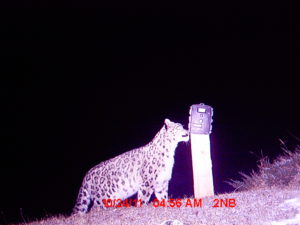Congratulations to all the SLN members involved in this project!
Telegraph.co.uk – A British-lead team of scientists has snapped rare intimate photographs of the elusive snow leopard on a remote mountain on the Tajik-Afghan border.
The photographs of the five snow leopards over a two month period in former Soviet Tajikistan suggest that the scientists may have discovered a hotspot for the endangered cat.
Dr Alex Diment, a scientist with Cambridge-based conservationist group Fauna and Flora International, was the expedition manager on the team of 25 people.
He described how they set up camera traps triggered by motion sensors along the side of an untouched valley for two weeks in August.
“We went up into the Wakhan range which is a mountain range on the border with Afghanistan,” Dr Diment said. “We’re pretty sure that it has never been surveyed for bio-diversity in that region.”
Snow leopards are so agile and so elusive that it is impossible for humans to physically track them.
Also in the group was Dr David Mallon, a snow leopard expert who is attached to Manchester Metropolitan University and is chairman of the Snow Leopard Network, a group dedicated to conserving the snow leopard.
Ten other scientists were Tajiks and the rest of the team were support staff.
The group returned to the valley two months later to collect their cameras and inspect the photographs.
“It was really surprising to have so many individuals,” he said of the snow leopards in the photographs. “I thought we might get one or two but to get five individuals in a small area, including a family with cubs was a great surprise. It was very exciting.”
The spotted pattern on the snow leopards’ white, grey body is unique to each cat, meaning they can be individually identified.
There are only an estimated 3,000 to 8,000 snow leopards left in the world. The wide estimate demonstrates the snow leopards’ elusiveness.
They typically live above an altitude of 4,000m on remote craggy mountains in Central Asia, China and Afghanistan. Trapping for their coats and a drop in prey have hit the snow leopard and driven them to the edge of extinction.
Photographs of the two cubs show them inspecting the cameras before they became so curious that they actually took one of the cameras away.
“We came back and we were missing a camera but had no idea what could have happened to it,” Dr Diment said.
The team searched without success and it wasn’t until they returned to the nearest city and looked at the memory card of another camera that they discovered the truth.
“There was the culprit stealing the camera,” he said. “They stole one of the cameras but the paired camera pointing at the other one showed them nicking it.”
Snow leopards retain a mystical allure in Central Asia and are depicted on the emblems of cities and organisations across the region. Almaty, Central Asia’s financial capital, and Bishkek, the Kyrgyz capital, both have snow leopards on their emblems.
In the Soviet Union, mountaineers who climbed all five peaks over the 7,000 metres were given the Snow Leopard Award.
http://www.telegraph.co.uk/news/worldnews/asia/tajikistan/9025294/Scientists-snap-rare-photos-of-snow-leopards-in-Tajikistan.html



